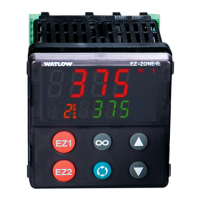Watlow EZ-ZONE
®
PM Integrated Controller • 116 • Chapter 10 Applications
When function is set for Ratio, the PV Function output
equals Source A as a ratio to Source B. Control loop 1
will control Analog Input 1 to Closed Loop Set Point 1.
Example 5: Differential
Requirements:
Two analog inputs and the enhanced software option
are required and at least one output adjusts the con-
trolled part of the process.
Overview:
Differential control maintains one process at a differ-
ence to another process.
When function is set for Differential, the PV Function
output equals Source A minus Source B. Control loop 1
will control Analog Input 1 difference to Analog Input
2 based on Closed Loop Set Point 1.
Example 6: Cascade
Requirements:
Two inputs and the enhanced software option are re-
quired and at least one output adjusts the controlled
part of the process.
Overview:
Cascade control can handle a difficult process with
minimal overshoot, while reaching the set point quick-
ly. This minimizes damage to system components
and allows for over sizing heaters for optimal heat-up
rates. Heater life is also extended by reducing thermal
cycling of the heater. Systems with long lag times be-
tween the energy source (heater, steam, etc.) and the
measured process value cannot be controlled accurately
Control Loop 1
Differential
Closed Loop
Set Point 1
Function
Filter
Source A
Source A
Source B
Heat Power
Cool Power
0 to 100%
0 to 100%
Output
Analog Input 1
Analog Input 2
Heat
Cool
Output n
Output n
PV Function
or efficiently with a single control loop, because a lot of
energy can build up before a response is detected. This
can cause the system to overshoot the set point, which
could damage the heater, product or heat transfer me-
dium, such as a heat transfer fluid.
When function is set for Process or Deviation Scale,
the Math Function output equals Source A scaled by
Range Low and Range High when Source E is False.
Source E disables cascade when True and Math Func-
tion output equals Control Loop 1- Closed Loop Set
Point. Control Loop 1 will control Analog Input 1 to
Closed Loop 1 Set Point and produce a remote set point
to Control Loop 2 based on the math scaling. Control
Loop 2 will control Analog Input 2 to the scaled value
from the Math Function interpreted as a remote set
point..
Example 7: Wet Bulb / Dry Bulb
Requirements:
Two analog inputs and the enhanced software option
are required and at least and at least outputs adjusts
the controlled part of the processes.
Overview:
Wet Bulb/Dry Bulb is a configuration where a dry bulb
connected to Analog Input 1 measures temperature on
Analog Input 1. A wet bulb sensor that is maintained
with moisture has air moved over the sensor. As mois-
ture evaporates from the wet bulb, the temperature
drops. A wet bulb input on Analog Input 2, in combi-
nation with the dry bulb temperature, senses relative
humidity. The controller calculates the temperature
difference between the two sensors to determine per-
cent relative humidity. The humidify and dehumidify
-100% = Range Low
+100% = Range High
Outer Loop
Control Loop 1
Control Loop 2
Inner Loop
Cascade
Filter
Scale Low
Scale High
Range High
Range Low
Function
Source A
Source A
Source A
Source B
Source B
Source E
Output
Power
Heat Power
Cool Power
Closed Loop SP
Math Function
dio
0 to 100%
0 to 100%
Remote SP
Analog Input 1
Analog Input 2
Process Sensor
Energy Source
Closed Loop
Set Point 1
Heat Algorithm
Remote
SP Enable
Cool Algorithm
Heat
Cool
Output n
Output n
Ratio
Closed Loop
Set Point 1
Function
Filter
Source A
Source A
Source B
Heat Power
Cool Power
0 to 100%
0 to 100%
Output
Heat
Cool
Output n
Output n
Analog Input 1
Analog Input 2
Control Loop 1
PV Function
controlled
uncontrolled

